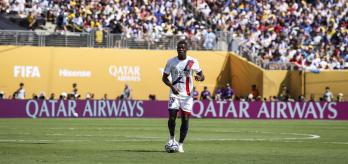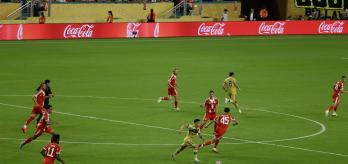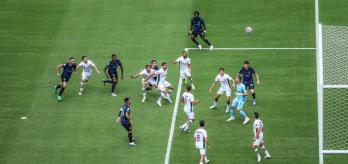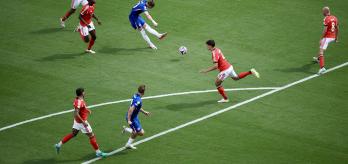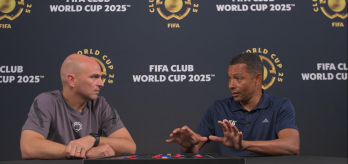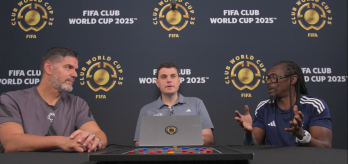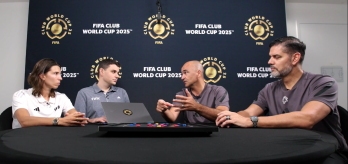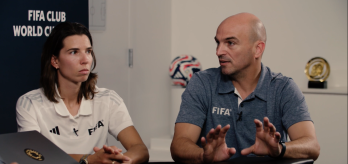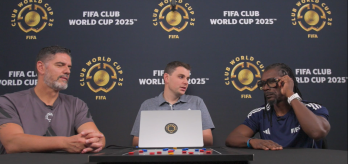The South African club are renowned for their “shoeshine and piano”, a possession-based playing philosophy grounded in precise, one-touch combinations across the pitch. At the FIFA Club World Cup, the Sundowns demonstrated that their style of play can compete on the global stage, beating Ulsan HD 1-0 in their opening game and taking Borussia Dortmund to the wire in a narrow 4-3 defeat. In this article, Technical Study Group (TSG) member Aliou Cissé explores the South African Premiership champions’ progressive build-up play, as seen in their match against Borussia Dortmund. The analysis is based on a match review with Cissé and Tom Gardner, Lead of FIFA’s Football Performance Insights Team.
Watch match review
A daring low build-up strategy
Against Borussia Dortmund, the Sundowns’ in-possession strategy stemmed from their goalkeeper, Ronwen Williams (30). Despite his hand in BVB’s first goal in the 16th minute, the South Africa national team captain continued to immerse himself in the build-up play in the deeper areas of the pitch. His willingness to act as the heart of his team’s strategy with the ball stood out and allowed the Sundowns to gain a numerical superiority in build-up against a high-pressing Dortmund side, explains Cissé.
“It was thanks to him [Williams] that they had that superiority. With the four at the back plus [Marcelo] Allende or [Teboho] Mokoena, which made five, plus Williams, they had six players involved in the low build-up play. They were then able to bring the ball out and find [Lucas] Ribeiro inside, the wingers out wide, or hit the front men directly.”
Clip 1 below features a typical example of Williams involving himself in his team’s build-up play. Williams gives the Sundowns the 5v3 numerical superiority needed to progress play further forward, explains Cissé.
“As you can see, the two centre-backs are quite far apart, and the full-backs are very high up the pitch. You can see how Mokoena comes in and creates a little overlap with Allende, which gives them the chance to play out.”
Data from FIFA’s Football Performance Insights Team reiterates Williams’ role as his team’s passing focal point. Against Borussia Dortmund, Williams performed 46 passes in low build-up phases (passes within the defensive third), which was more than any other player on either team. The Bafana Bafana captain also recorded the two highest numbers of passes in open play by a goalkeeper in the tournament so far (after 25 matches have been played).
Rotations and pinning the opposition
The Sundowns’ centre-midfielders were key in progressing the build-up from the defensive third into more advanced areas of the pitch. Mokoena (4) and Allende (11), the two holding midfielders in the team’s 4-2-3-1 structure, coordinated their runs to open passing lanes and create space. As one looked to receive the ball by dropping towards the ball carrier, the other would often run in the opposite direction to drag a Borussia Dortmund midfielder with them, freeing central areas for team-mates Themba Zwane (18) and Lucas Ribeiro Costa (10) to rotate into and receive the ball.
The plots in the graphic below indicate every instance where Mokoena received the ball whilst either in front of or within Dortmund’s most forward unit of players. The midfielder’s rotations were active throughout the match, and some of the 46 total receptions in front of the opposition’s team shape were in situations where Mokoena would deliberately drop in to receive a pass, as seen in clip 2 below. Despite its simple aesthetic, “shoeshine and piano” demands constant movement from the centre-midfielders to combine with Williams and the Sundowns defenders when building out into more attacking areas.
Amidst the movement from the Sundowns midfielders, the positioning of Iqraam Rayners (13) was critical. The forward would hold his position centrally to pin the Dortmund defenders in place. For Cissé, when Sundowns looked to progress play from the middle third to attacking areas of the pitch, Rayners’ positional play became key.
“If you don’t have someone pinning the opponent, you don’t score. When there’s someone pinning, it forces the opposition to take up the same positions as you. And when the opposition does that, they think they’re well-positioned when, in actual fact, they’re not. So what he does is lock the whole Dortmund defence. This allows the others to hit balls into space.”
Cissé points out that the entire tactical sequence of Mamelodi Sundowns’ build-up and attacking strategy came together for the side’s first goal against Dortmund.
“As you can see, Williams lets the left winger know straight away. What you have to watch then is how Rayners pins the opposition on the inside – he doesn’t go outside. If you look, it’s [Khuliso] Mudau at the bottom of the clip, who is virtually a winger. The winger comes inside, and the defence is completely open. But it all happens because of the movement and players occupying zones.”







